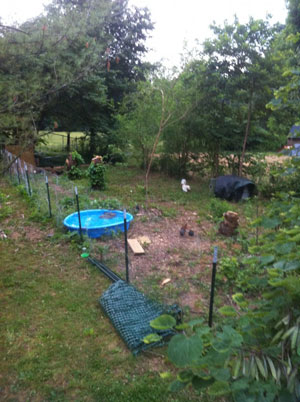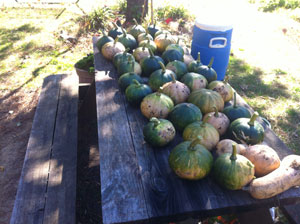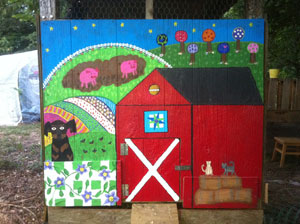
Our chicks and ducklings shipped yesterday (Monday April 16th 2012) and should be arriving tomorrow or the next day. So it was time to put together a couple of brooders. I needed one for the 20 or so chicks and one for the couple of ducklings. Baby chickens and baby ducks should not be keep together because ducks get the brooder very wet which can cause problems for the baby chicks. We ordered 10 Black Australorps for our laying flock, 10 dark cornish for our meat birds, and 2 fawn runner ducks.
It’s a good idea to have your brooder set up in advance of getting your chicks so they can almost immediately be introduced to their new home, get warmed up, and get some water and food. This is especially important when ordering by mail as we did.







 We will possibly be getting our first frost of the year tonight. I harvested the rest of the butternut winter squash and Seminole pumpkins. Many of them where still not all the way ripe. So I was wondering what you could do with unripe winter squash and pumpkins? According to a blog post I found, you can clean them up, bring them inside, and put them in a warm sunny place to finish ripening.
We will possibly be getting our first frost of the year tonight. I harvested the rest of the butternut winter squash and Seminole pumpkins. Many of them where still not all the way ripe. So I was wondering what you could do with unripe winter squash and pumpkins? According to a blog post I found, you can clean them up, bring them inside, and put them in a warm sunny place to finish ripening.

 We recently bought a Little Giant 3 Gallon Plastic Poultry Waterer for our ducks and chickens. It looked like it would be a great waterer for the ducks. It has a deep bottom dish which is great for the ducks to dip and clean their bills in. When I got it home and filled it up, the water just keep pouring out of the bottom hole and overflowing. I couldn’t figure out what I was doing wrong.
We recently bought a Little Giant 3 Gallon Plastic Poultry Waterer for our ducks and chickens. It looked like it would be a great waterer for the ducks. It has a deep bottom dish which is great for the ducks to dip and clean their bills in. When I got it home and filled it up, the water just keep pouring out of the bottom hole and overflowing. I couldn’t figure out what I was doing wrong. Happy Father’s Day to all of the Dads out there. My wife and kids added some cool folk art to the chicken coop as a surprise for Father’s Day. They did an awesome job! Surprises like this are really special and I’ll be reminded of this Father’s Day everyday when I visit the coop.
Happy Father’s Day to all of the Dads out there. My wife and kids added some cool folk art to the chicken coop as a surprise for Father’s Day. They did an awesome job! Surprises like this are really special and I’ll be reminded of this Father’s Day everyday when I visit the coop.



 With 2012 being the first year we raised chickens for meat, we had a huge learning curve on how to butcher our own chickens. With the first spring flock, the butchering process was very slow. It was taking us 30-40 minutes to pluck 1 chicken. We raised 25 more in the fall of 2012. This time the plucking time went much faster. For one, we were more experienced and had learned from our mistakes. We also had a new tool called the Power Plucker.
With 2012 being the first year we raised chickens for meat, we had a huge learning curve on how to butcher our own chickens. With the first spring flock, the butchering process was very slow. It was taking us 30-40 minutes to pluck 1 chicken. We raised 25 more in the fall of 2012. This time the plucking time went much faster. For one, we were more experienced and had learned from our mistakes. We also had a new tool called the Power Plucker.

 We use the Genesis 1588 Hova-Bator to incubate and hatch our chickens and ducks for our homestead. The incubator comes with a very informative instruction manual that explains the set up and operation of the incubator. This post will give anyone interested in purchasing an incubator (specifically the 1588 Hova-Bator) a good understanding of the basics of the process. In 2013 we hatched one batch of chickens in the spring and one in the fall using the Hova-Bator with very good success. The information will be a based on our experience using the incubator based on the instructions provided and thePermaculture Chicken: Incubation Handbook by Anna Hess.
We use the Genesis 1588 Hova-Bator to incubate and hatch our chickens and ducks for our homestead. The incubator comes with a very informative instruction manual that explains the set up and operation of the incubator. This post will give anyone interested in purchasing an incubator (specifically the 1588 Hova-Bator) a good understanding of the basics of the process. In 2013 we hatched one batch of chickens in the spring and one in the fall using the Hova-Bator with very good success. The information will be a based on our experience using the incubator based on the instructions provided and thePermaculture Chicken: Incubation Handbook by Anna Hess.